First of all, clean and then boil the potatoes with their skins on, in water for around 20 minutes. Whilst that it cooking, we can get on with the next stage.
Next, make a total of around 300mls of the yeast suspension according to the recipe.
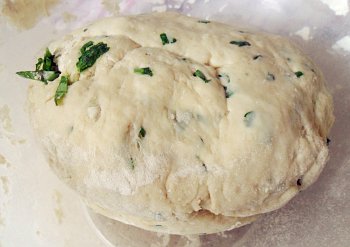 |
Just white bread dough with chopped coriander leaf.
1 |
Put the flour, in a bowl, and mix some of the coriander leaf in it - note that the leaf should be cut up quite small because the leaves disrupt the dough's ability to stay together so if you have a lot of big pieces of coriander, the dough will tend to split.
Make a well in the middle and put it in the microwave oven for between 10 and 20 seconds to warm through - this means that when you add the warm yeast suspension, it will not suddenly cool down and stop working.
Not having to wait whilst the yeast restarts will save you time.
Mix in the water, a little at a time until you have enough to make a reasonably pliable dough, suitable for making white bread.
Put the dough in the bowl, cover it with a clean, dry tea towel and put in a warm, dry place.
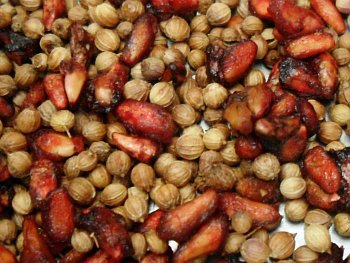 |
Anardana (pomegranate seeds)
and coriander seeds. |
We now need to roast and crush some coriander and anardana.
Basically, you put them in a dry saucepan and heat them up fairly slowly until the coriander starts to smoke, signifying that the coriander is done.
Then you put them in a mortar and crush them coarsely with the pestle.
However, the anardana is substantially harder to crush than the coriander so you might want to roast it first.
Another thing about anardana is that it still has a lot of the pomegranate gel on it so it tends to be sticky when you heat it up.
One way around this - if you really want to roast them together - is to put the roasted seeds into a grinder, rather than doing it by hand.
Another way around this instead of using anardana, just leave it out and process the coriander seeds and then add a teaspoon of pomegranate molasses to the potato when you mix it all together.
Your call.
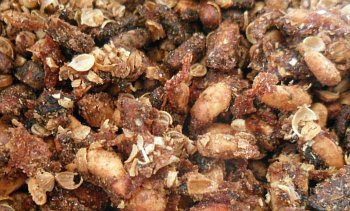 |
Roast anardana and
coriander, crushed. |
This is how coarse it is if you use a mortar and pestle, having cooked them together.
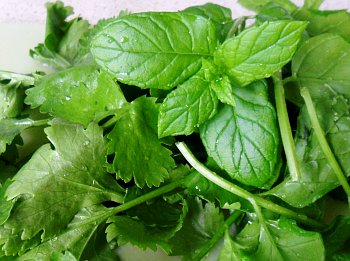 |
Fresh mint and coriander leaf for the filling.
|
Wash the mint leaf and the coriander leaf and shake them dry.
Chop them up fairly small, although you don't have to make it as small as the coriander leaf that you put in the dough.
 |
Potato, onions, garlic, ginger,
coriander, mint and so on. |
In a saucepan, in some oil, fry the chillies for half a minutes and then add the onions and fry until they are done.
Take the potatoes out of the water and break them open, adding the dry fluffy mash to the onions.
Add the roast, crushed anardana and coriander seeds, along with the mint, coriander leaf garlic and ginger.
Finally, add 1tsp of lemon juice.
Mix it up and put it to one side for a moment whilst you prepare the dough.
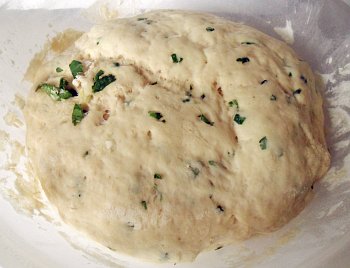 |
In the meantime, the dough has risen somewhat.
|
Take the dough out of the bowl and knead it.
Put it back in the bowl and cover it.
 |
Take a small piece of dough
(5cm diameter ball). |
Break off a small piece - enough to make a ball of around 7cm in diameter and divide it equally.
Roll them into balls - you are dividing it now because you need two identical balls. If you took another piece of dough later on, it would not be the same quantity because the dough would have risen in the meantime.
Using your thumb and forefinger, make a flattened shape out of it, with thicker edges.
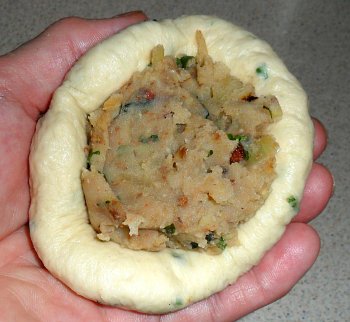 |
Put some of the stuffing in it,
leaving a space around the top. |
Put some of the filling in the middle of the dough, leaving a space around the edge of it.
Carefully pull that edge inwards so that it thickens and meets ...
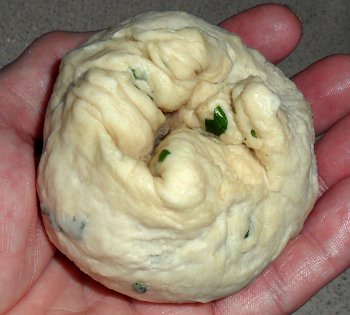 |
Pull that surplus inwards,
making it meet. |
... sealing off the top of the kulcha.
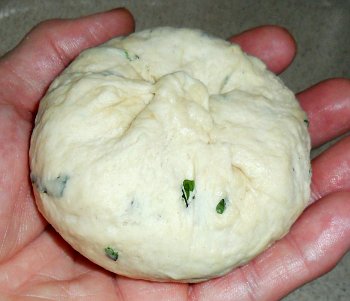 |
Seal it off.
|
Seal off the top.
Flatten it a little bit but not by much.
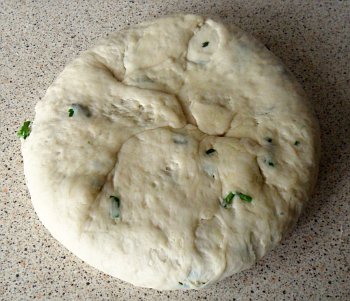 |
Repeat with another piece of dough
so that the dough is double-layered. |
You can now repeat the process by flattening out the other dough piece and placing this piece, sealed side down - so that one piece's seals face is in the middle of the other piece.
Bring it together, like you did before and make a seal again.
The filling is now locked inside two layers.
Sprinkle some klowunji seeds on the two faces and press it flatter.
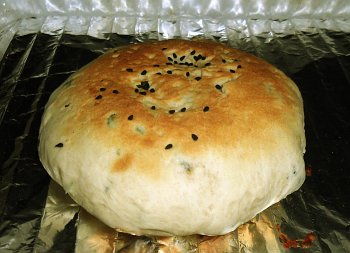 |
Cook it under a medium grill
or in an oven. |
Now, grill it on a medium flame so that it has time for the dough to cook.
They should rise up, looking somewhere between this and a circular naan bread.
Note that these here, have been made with two layers, pinched together to make a seal.
As an alternative, you can use one layer.
As another alternative, you can use the 'kulcha analogue' of the two stuffed paratha methods described here.
Essentially: you roll out an oversized piece of dough, put the filling on it and then fold it over - repeating it with another piece so that you have folds on both sides and a double-layer bread seal; or,
you roll out a piece of dough, put on the filling, going close to the edge but leaving enough of a space for sealing it, put an equally-sized piece on it and seal it around the edges. Roll it out a bit more and then cook it.
 |
This is the kulcha broken open so you can see the layer inside.
|